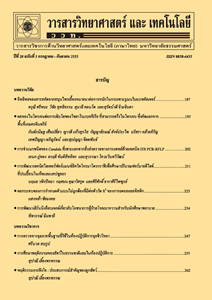การพัฒนาผลิตภัณฑ์เส้นก๋วยเตี๋ยวจากปลานวลจันทร์เสริมสาหร่ายพวงองุ่น
Main Article Content
Abstract
The aim of this study is to develop milkfish noodles mixed with green caviar from Sea Farm Royal Project initiated by HM Queen Sirikit, Phetchaburi province, Thailand. The study of different proportions of milkfish mixed with chicken breast (100, 90, 80 and 70 %), and the study of the different proportions of tilapia in place of chicken breast (0, 10, 15 and 20 %) were carried out. In addition, the study of the different proportions of green caviar powder (0, 1, 1.5 and 2 %) was also achieved. It was found that most of the expert panelists preferred the formulation with 70 % of milkfish, 10 % of chicken breast and 20 % of tilapia and green caviars as an extra ingredient, was mostly preferred at 1.5 %. Then, 30 general consumers were asked to rate the noodles based on the five sensory traits-color, smell, flavor, texture, taste and overall preference score which were considered highly and acceptable. Thus this formula was used in storage test to monitor physical and chemical changes, and the growth of microorganism at 5-8 °C for 20 days. It was found that the product slightly turned brown. The pH value decreased, whereas the total plate counts and yeast increased. Mold was not detected in the product. The product spoilage accelerated within five days of storage. The results of nutritional analysis revealed that the product was rich in high-quality protein, iron, and vitamin B1, but low in fat.
Keywords: milkfish; green caviar; noodle from fish
Article Details
References
[2] วัชรี คงรัตน์ และอรวรรณ คงพันธุ์, การพัฒนาผลิตภัณฑ์จากปลานวลจันทร์, กองวิจัยและพัฒนาอุตสาหกรรมสัตว์น้ำ กรมประมง, แหล่ง ที่มา : http://www.fisheries.go.th/industry/ files/archives/2558-8.pdf, 28 เมษายน 2559.
[3] มณีวรรณ์ วงศ์นอก, 2555, เมนูอาหารจากปลาคุ้มค่าเพราะกินได้ทั้งตัว, สำนักงานประมง จังหวัดอุบลราชธานี, 16 น.
[4] Ratana-Arporn, P. and Chirapart, A., 2006, Nutrition evaluation of tropical green seaweeds Caulerpa lentillifera and Ulva reticulate, Kasetsart J. (Nat. Sci.) 40: 75-83.
[5] Smith, D.M., 1991, Factors influencing heat induced gelation of muscle protein, p. 243-256, In Paris, N. and Bradford, R. (Eds.), Interactions of Food Proteins, American Chemical Society, Washington, DC.
[6] เสน่ห์ บัวสนิท, สิริวรรณ สุขนิคม และฌนกร หยกสหชาติ, การพัฒนาผลิตภัณฑ์เพื่อเพิ่มมูลค่าปลานิลของอำเภอบางระจัน จังหวัดสิงห์บุรี, แหล่งที่มา : http://herp-nru.psru.ac.th/file/ A54068_12.pdf, 20 เมษายน 2559.
[7] Tachasirinukun, P., Chaijan, M. and Riebroy, S., 2016, Effect of setting conditions on proteolysis and gelling properties of spotted featherback (Chitala ornata) muscle, LWT Food Sci. Technol. 66: 318-323.
[8] จิรวัฒน์ ยงสวัสดิกุล, 2546, การทำบริสุทธิ์และคุณลักษณะทางชีวเคมีของทรานสกลูทามิเนสจากปลานิล, รายงานการวิจัย, ศูนย์พันธุวิศวกรรมและเทคโนโลยีชีวภาพแห่งชาติ สำนักงานพัฒนาวิทยาศาสตร์และเทคโนโลยีแห่งชาติ, กรุงเทพฯ.
[9] จิรวัฒน์ ยงสวัสดิกุล, กนกอร อินทราพิเชฐ, สุเวทย์ นิงสานนท์ และหนึ่ง เตียอำรุง, 2547, การพัฒนากระบวนการผลิตลูกชิ้นและไส้กรอกจากปลานํ้าจืด, รายงานการวิจัย, ศูนย์พันธุวิศวกรรมและเทคโนโลยีชีวภาพแห่งชาติ สำนักงานพัฒนาวิทยาศาสตร์และเทคโนโลยีแห่งชาติ, กรุงเทพฯ.
[10] BAM, 2001, Bacteriological Analytical Manual, Available Source: https://www. fda.gov/food/foodscienceresearch/laboratorymethods/ucm063346.htm, 28 Decem-ber 2016.
[11] AOAC, 2016, Official Methods of Analysis, 20th Ed., Association of Official Analytical Chemists, Virginia, USA.
[12] Worratao, A. and Yongsawatdigul, J., 2003, Cross-linking of actomyosin by crude tilapia (Oreochromis niloticus) transglutaminase, J. Food Biochem. 27: 35-51.
[13] Morioka, K. and Shimizu, Y., 1990, Contribution of sarcoplasmic proteins to gel formation of fish meat, Nippon Suisan Gakkaishi 56: 929-933.
[14] Morioka, K. and Shimizu, Y., 1993, Relationship between the heat-gelling property and composition of fish sarcoplasmic proteins, Nippon Suisan Gakkaishi 56: 929-993.
[15] Okazaki, E., Kanna, K. and Suzuki, T., 1986, Effect of sarcoplasmic protein on rheological properties of fish meat gel formed by retort heating, Nippon Suisan Gakkaishi 52: 1821-1827.
[16] Dryden, F.D. and Birdsall, R.A. (Eds.), 1980, Why nitrite does not impart color, Food Technol. 15(2): 29-42.
[17] Bircan, C. and Barringer, S.A., 2009, Heat changes protein structure: Frying an egg, J. Food Sci. 74: 202-205.
[18] มาตรฐานผลิตภัณฑ์ชุมชนลูกชิ้นปลาเลขที่ ๓๒๘/๒๕๔๗, 2547, มาตรฐานผลิตภัณฑ์ชุมชนลูกชิ้นปลา, สำนักงานมาตรฐานผลิตภัณฑ์อุตสาหกรรม, กรุงเทพฯ.

